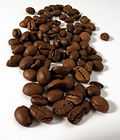Coffee production in Cuba

Coffee has been grown in Cuba since the mid-18th Century. Boosted by French farmers fleeing the revolution in Haiti, coffee farms expanded from the western plains to the nearby mountain ranges.[1]
History
Coffee production in eastern Cuba during the 19th and early 20th centuries "resulted in the creation of a unique cultural landscape, illustrating a significant stage in the development of this form of agriculture." As such, UNESCO has listed Santiago and Guantanamo Provinces, South-Eastern Region as a World Heritage Site since 2000.[2] Prior to the Castro era, Cuba’s coffee industry prospered. In the mid-1950s, Cuba was exporting more than 20,000 metric tons of coffee beans per year. Cuban coffee sold at premium prices on world markets. Much of that coffee was exported to Europe, particularly the Netherlands and Germany. Little was sold in the United States as U.S. consumers were unwilling to pay a premium for Cuban coffee.
Production
By the 21st century, 92% of the country's coffee was grown in area of the Sierra Maestra mountains. The coffee harvest runs September through January, but peaks in October and November.[3]
The island produces both arabica and robusta beans, with most production coming from small family farms.[4] In 2003, Cuba began exporting organic coffee to Europe and Japan, with more than 4,000 hectares certified as organic. Centered in the eastern portion of the island, the area produced 103 tons of organic coffee that was selling at prices 40% higher than the standard Cuban coffee.[5]
According to the FAO, the total number of hectares where green coffee is harvested in Cuba has fallen from 170,000 in 1961 to 26,935 in 2011.[6]
Distribution
All coffee from Cuba is exported by Cubaexport, which pays a government-regulated, fixed price to coffee growers and processors for their coffee.[7] Currently, Japan and France are Cuba’s major coffee export markets, with smaller amounts going to Germany, the United Kingdom, Canada, and New Zealand.[8]
See also
Cuba portal
Coffee portal
References
- ↑ "Cuba:A Once-Proud Coffee Industry Falls On Hard Times". Tea & Coffee Trade Journal. Retrieved 13 February 2013.
- ↑ "Archaeological Landscape of the First Coffee Plantations in the South-East of Cuba". UNESCO World Heritage Centre. Retrieved 18 February 2013.
- ↑ Craggs, Ryan (29 October 2012). "Hurricane Sandy Decimates Cuban Coffee Crop". Huffington Post Canada. Retrieved 13 February 2013.
- ↑ "The dark secret of Cuban coffee". The Toronto Star. 27 October 2007. Retrieved 13 February 2013.
- ↑ "Cuba enters market for organic products". GRANMA INTERNATIONAL/ONLINE EDITION. Retrieved 13 February 2013.
- ↑ "FAOSTAT ( done by selecting the necessary data points from the list)". FAO.org. Retrieved 13 February 2013.
- ↑ "Cuba’s Food & Agriculture Situation Report" (PDF). Office of Global Analysis, FAS, USDA. March 2008. Retrieved 18 February 2013.
- ↑ "Cuba’s Food & Agriculture Situation Report" (PDF). Office of Global Analysis, FAS, USDA. March 2008. Retrieved 18 February 2013.
- Note: Portions of this article include public domain text from the USDA Cuba’s Food & Agriculture Situation Report.
External links
-
 Media related to Coffee in Cuba at Wikimedia Commons
Media related to Coffee in Cuba at Wikimedia Commons
| |||||||||||||||||||||||||||||||||||||||||||||||||||||
